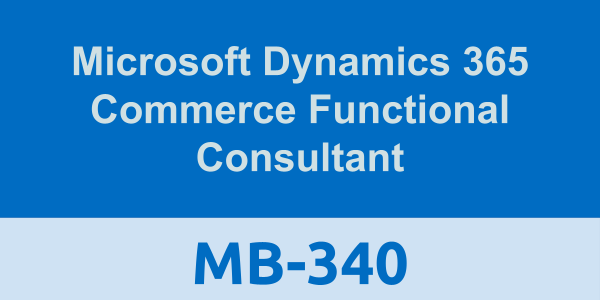Candidates for this exam set up and use the application functionality in Dynamics 365 Commerce and provide support for the application.
Candidates have a strong understanding of unified commerce business operations. They may have experience configuring, deploying, and maintaining Dynamics 365 Commerce.
Microsoft Commerce Functional Consultant Exam Summary:
| Exam Name | Microsoft Certified - Dynamics 365 Commerce Functional Consultant Associate |
| Exam Code | MB-340 |
| Exam Price | $165 (USD) |
| Exam Price | 90 mins |
| Number of Questions | 40-60 |
| Passing Score | 700 / 1000 |
| Sample Questions | Microsoft Commerce Functional Consultant Sample Questions |
| Practice Exam | Microsoft MB-340 Certification Practice Exam |
Microsoft MB-340 Exam Syllabus Topics:
| Topic | Details |
| Configure Dynamics 365 Commerce Headquarters (25–30%) | |
| Configure prerequisites and commerce parameters | - Create employee and customer address books - Configure and manage retail workers - Assign address books to customers, channels, and workers - Create email templates and email notification profiles - Configure organizational hierarchies and hierarchy purposes - Configure Commerce shared parameters - Configure company-specific Commerce parameters |
| Describe and configure additional functionality | - Create and configure channel and sales order attributes - Configure commissions and sales representatives - Configure payment methods and card types - Configure and manage gift cards - Describe Omni-channel capabilities including payments, orders, returns, and refunds - Configure data distribution - Create info codes, sub-codes, and info code groups - Describe Dynamics 365 Fraud Protection purchase protection, loss prevention, and account protection |
| Manage statements | - Describe advantages of using trickle feed-based posting - Validate retail transactions by using the transaction consistency checker - Configure and manage retail statement calculations and posting - Troubleshoot statement posting issues |
| Configure Distributed Order Management (DOM) | - Configure fulfillment profiles - Configure cost components including shipping, handling, and packaging costs - Configure management rules and parameters - Monitor fulfillment plans and order exceptions |
| Configure order fulfillment | - Configure modes of delivery including shipments, pick up, and carry out - Configure curbside customer order pickup - Configure charge codes, charge groups, and automatic charges - Configure and assign order fulfillment groups |
| Configure products, prices, discounts, loyalty, and affiliations (25– 30%) | |
| Configure products and merchandising | - Configure product category hierarchies - Configure product attributes and attribute groups - Configure assortments - Manage product labels and shelf labels - Describe uses cases for recommendation types including product, personalized, Shop similar looks, and Shop similar descriptions recommendations - Configure recommendations - Configure warranty settings - Configure inventory buffers and inventory levels - Configure products and variants including configuring barcodes |
| Manage pricing | - Design and create price groups - Configure pricing priorities - Configure product pricing including smart rounding - Configure catalog pricing - Configure affiliation pricing - Configure category pricing rules |
| Manage discounts and promotions | - Configure discount parameters - Configure channel or customer-specific discounts - Configure quantity, shipping, tender-based, and threshold-based discounts - Configure discount concurrency rules - Manage coupons |
| Manage customers, loyalty, and affiliations | - Configure client books - Configure customer attributes - Configure customer affiliations - Configure loyalty programs, loyalty schemes, and reward points - Manage loyalty tier calculations and processing |
| Manage Point of Sale (POS) in Dynamics 365 Commerce (15–20%) | |
| Configure retail stores | - Create a retail store - Configure POS registers and devices - Configure retail profiles - Configure sales tax overrides - Configure Task Management lists and parameters - Define cash management processes - Define shifts and shift management processes - Configure channel return policies - Describe offline capabilities and limitations |
| Manage store inventory | - Configure availability calculations for products - Manage inbound and outbound inventory operations within the POS - Process customer pick-up and shipment orders - Manage inventory processes including stock counts - Look up product inventory - Process serialized items |
| Perform POS operations | - Perform sales and order processes - Perform end of day processes - Reconcile store cash - Monitor store productivity by using Task Management and reporting features |
| Configure and Manage Dynamics 365 Commerce call centers (10-15%) | |
| Configure call centers | - Create a call center - Configure and publish product catalogs - Create product catalog scripts - Configure fraud conditions, rules, and variables to trigger order holds - Configure fraud alerts |
| Configure continuity orders and installment billing | - Set up continuity programs and parameters - Configure continuity order batch jobs - Manage continuity child orders |
| Manage call centers | - Create, modify, and process sales orders - Process call center payments - Manage order holds - Create return merchandise authorizations (RMAs) - Process returns, exchanges, and replacements |
| Manage e-commerce (15-20%) | |
| Configure an e-commerce channel | - Create an online store - Configure an e-commerce site - Configure channel assignments for an e-commerce site - Configure ratings and reviews |
| Manage e-commerce content | - Configure URLs and aliases - Configure product detail pages and category pages - Manage site themes, page fragments, templates, layouts, and pages - Upload and manage digital assets including videos and images - Set focal points and attribute values for media assets - Configure publish groups |
| Operate an e-commerce channel | - Create e-commerce orders - Synchronize e-commerce orders - Moderate ratings and reviews |
| Configure business-to-business (B2B) e-commerce | - Describe differences between B2B and business-to-consumer (B2C) solutions - Describe use cases for organizational modeling hierarchies - Manage business partners and business partner users - Configure product quantity limits |





0 comments:
Post a Comment